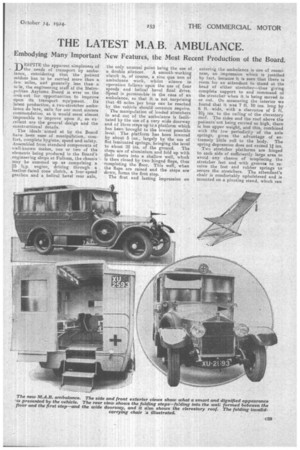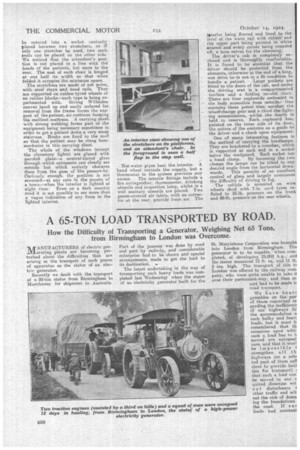THE LATEST M.A.B. AMBULANCE.
Page 13

Page 14

If you've noticed an error in this article please click here to report it so we can fix it.
Embodying Many Important New Features, the Most Recent Production of the Board.
DESPITE the apparent simpleness of the needs of transport by ambulance, considering that the patient seldom has to be carried more than a few miles, and generally less than a niqe, the engineering staff of the Metropolitan Asylums Board is ever on the took-out for opportunities to improve upon its transport equ;pment. Its latest production, a two-stretcher ambulance de luxe, calls for our most sincere commendation, as it would seem almost impossible to improve upon it, so excellent are the general design and the constructional details.
The ideals aimed at by the Board have been ease of maniputation, comfort, complete hygiene, speed and safety. Assembled from standard components of well-known makes, one or two of the elements being produced in the Board's engineering shops at Fulham, the chassis may be summed up as comprising a
25 engine, driving through a leather-faced cone clutch, a four-speed gearbox .and a helical bevel rear axle,
the only unusual point being the use of a double silencer. A smooth-working clutch is, of course, a sine qua non of ambulance work, whilst silence in operation follows upon the use ot four speeds and helical bevel final drive. Speed is permissible in the case of an ambulance, so that it is not surprising that 45 miles per hour can be reached by the vehicle should occasion require. The manipulation of loaded stretchers in and out of the ambulance is facilitated by the use of a very wide doorway and of three steps up to a platform which has been brought to the lowest possible level. The platform has been lowered by about 5 ins., largely by the use of flat laminated springs, bringing the level to about 28 ins, of the ground. The steps are of aluminium and fold up with their risers into a shallow well, which is then closed by two hinged flaps, thus completing the floor. This well, when the flaps are raised and the steps are down, forms the first step.. The first and lasting impression on entering the ambulance is one of roominess, an .impression which is justified by fact, because it is seen that there is room for an attendant to stand at the head of either stretcher—thus giving complete support to and command of the stretcher when it is being moved in Or out. On measuring the interior we found that it was 7 ft. 10 ins. long by 6 ft. wide, with a clearance of 5 ft. 10i ins, to the ceiling of the clerestory roof. The sides and the roof above the patients not being carried so high, there is less upper weight, and this, combined with the low periodicity of the axle springs, gives the advantage of ex
tremely little roll to the body. The spring depression does not exceed 1 ins.
Two stretcher platforms are hinged to each side of sufficiently large area to avoid any chance of misplacing the stretcher feet and with grooves to receive the feet and rubber springs to secure the stretchers. The attendant's chair is comfortably upholstered and is mounted on a pivoting stand, which can
be entered into a socket centrally placed between two stretchers, or if only one stretcher be used, two such seats can be placed on the other side. We noticed that the attendant's position is riot placed in a line with tl4 heads of the patients, but m,ore to the rear. The seat of each chair is hinged at one half its width so that when folded it occupies the minimum space. The stretchers are made of ash poles, with steel stays and head rails. They are supported on rubber-tyred wheels or on rubber blocks—each type is being experimented with. Strong Willesden canvas laced up and easily unlaced for removal from the frame forms the support of the patient, air cushions forming the resilient mattress. A carrying sheet with strong webbing forms part of the equipment being necessary sometimes in order to get 'a.patient down a very steep staircase. Hooks are fixed to the roof .so that the patient may be slung hamrnockwise in this carrying sheet.
• The whole of the windows (except the clerestory lights) are glazed with eyardoli, glass—a neutral-tinted glass through which occupants can clearly see outside but which entirely obscures them from the gaze of the passers-by. Curiously enough, the position is not reversed—at any rate in the streets of a town—when the interior is lighted at night time. Even on a dark country road it is not possible to see more than a vague indication of any form in the lighted interior. Hot-water pipes heat the interior. A hand wheel controls the supply, but a thermostat in the system prevents any excess. The interior fittings include a fire extinguisher, thermometer, drinking utensils and inspection lamp, whilst in a well sanitary utensils are placed. Two gauze-covered air inlets, with an extractor at the rear, provide fresh air. The i*terior being floored and lined talw the level of the waist rail with rubber and the upper part being painted in white enamel and every corner being rounded off, a hose serves for the cleansing.
The driver's cab is completely enclosed and is thoroughly comfortable. ft is found to be essential that the -driver should be protected from the elements, otherwise at the end of a long, wet drive he is not in a fit condition to
handle a patient. Large pockets are fitted to the doors of the cab, and under the driving seat is a compartmented toolbox and a folding invalid chair. There are four cupboards embraced in the body accessible from outside.One contains three petrol -tins, another the wheel-change gear and a third the lighting acclunalators, whilst the fourth is held in reserve. Each cupboard 'has, painted on the inner side of its door, the nature of the contents as a guide to the driver and a cheek upon equipment.
One of many interesting features is the method of carrying the headlamps. They are bracketed to a crossbar, which is supported at each end in a socket below the mudguard. Each socket has a hand clamp. By loosening the two clamps the lamps can he tilted to any deslred angle from the horizontal down wards. This permits of an excellent control of glare and largely overcomes the difficulty of driving in fog. The vehicle is mounted on wire wheels shod with 7-in, cord tyres inflated to 55-1b. pressure on the front and 40-lb. pressure an the rear wheels.






























